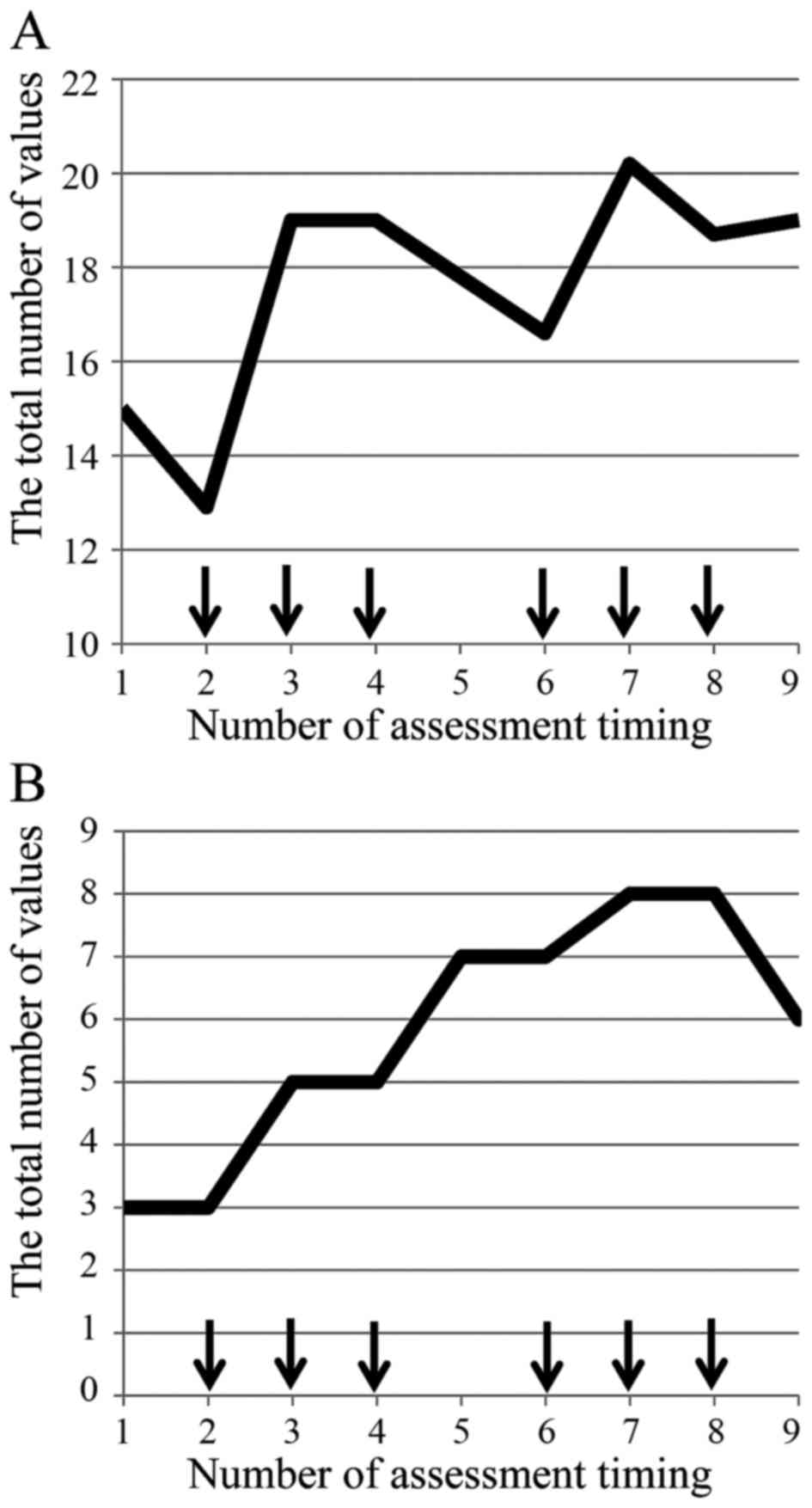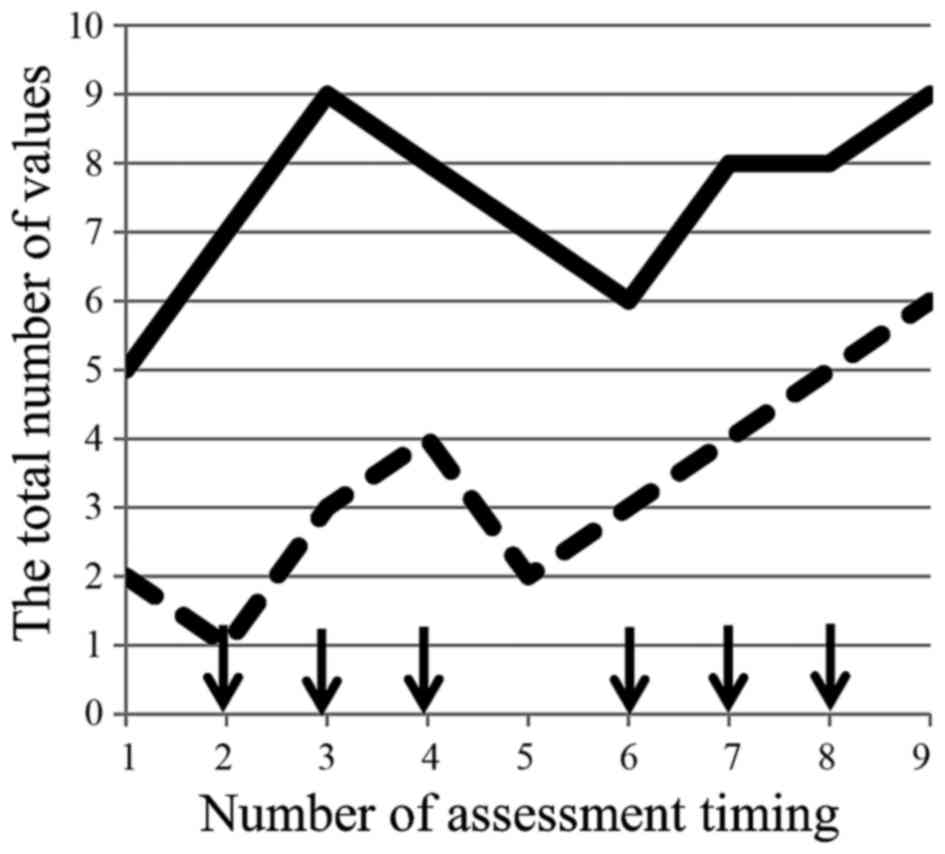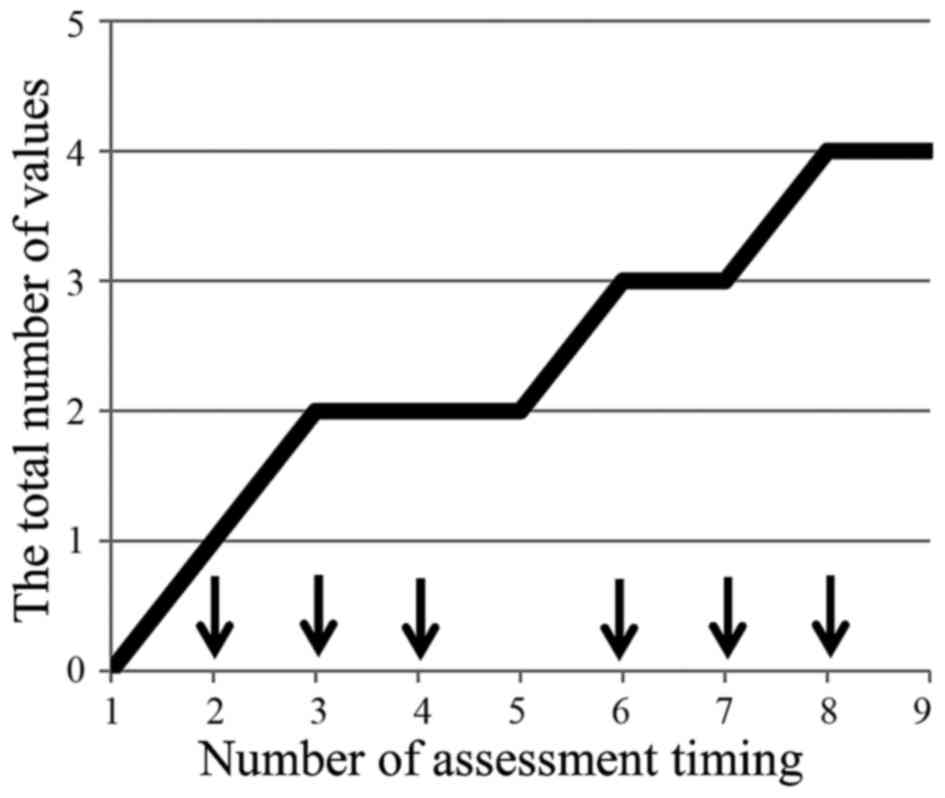Prospective validation of patient fatigue questionnaire (FACIT‑F) for fatigue assessment in nab‑paclitaxel plus gemcitabine therapy
- Authors:
- Published online on: November 3, 2017 https://doi.org/10.3892/mco.2017.1485
- Pages: 121-126
Abstract
Introduction
Pancreatic cancer is projected to surpass breast, prostate, and colorectal cancers to become the second leading cause of cancer-related death by 2030. It is associated with extremely poor prognosis (1,2). Patients with advanced pancreatic carcinoma usually present some extent of accompanying fatigue. After the introduction of recent stronger regimen of chemotherapy, patients presented a high incidence of fatigue (3,4). Fatigue impairs patients' physical and mental energy, directly and indirectly influencing the sustainability of chemotherapy. Nab-paclitaxel plus gemcitabine is a standard therapy and a promising treatment for unresectable pancreatic cancer (URPC) including metastatic/locally advanced pancreatic cancer (3). In an international multicenter open-label randomized phase 3 study, Von Hoff et al reported the considerable frequency of treatment-related adverse events rated grade 3 or higher of the nab-paclitaxel plus gemcitabine therapy as neutropenia (38%), leucopenia (31%), fatigue (17%), and peripheral neuropathy (17%) (3). Frequency and degree gradually rise, particularly during chemotherapy, significantly impacting on quality of life of URPC patients. Quality of life is easily impaired by fatigue and peripheral neuropathy in patients who receive nab-paclitaxel plus gemcitabine therapy (5). Patient-reported outcomes are useful for evaluating adverse effects that are difficult to assess objectively by physicians. Functional Assessment of Chronic Illness Therapy-Fatigue (FACIT-F) questionnaire (6,7) and Patient Neurotoxicity Questionnaire (PNQ) (8) have been utilized to assess patient-reported outcomes of cancer treatments such as chemotherapy or chemoradiotherapy to adjust to sustainable dosage of agents. However, the feasibility and sensitivity of fatigue assessment in patients receiving recent stronger chemotherapy regimen is unknown.
We prospectively investigated the feasibility and validity of a patient-based scale, FACIT-F Questionnaire, PNQ, toxicities, and adverse effects evaluated in accordance with Common Terminology Criteria for Adverse Events (CTCAE) version 4.0 (9) for cumulative fatigue and peripheral neuropathy in the timing of the introduction of nab-paclitaxel plus gemcitabine therapy. The data from this study could be useful for identifying appropriate timing and duration of medical intervention for supporting therapy in nab-paclitaxel plus gemcitabine therapy.
Patients and methods
Patients
The present study was approved by the Wakayama Medical University Hospital Institutional Review Board (approval no. 1771). This trial is registered on the UMIN Clinical Trials Registry (UMIN000021758). We excluded patients with severe comorbidity, such as severe cardiac/renal failure or bowel obstruction and those unable to intake oral medicine, to facilitate comparison of data with the next interventional trial (UMIN000025606) where endpoints are defined identically to this study. Criteria of eligible patients enrolled in this study were as follows: Patients with URPC who received nab-paclitaxel plus gemcitabine therapy as a first line chemotherapy and had an Eastern Cooperative Oncology Group (ECOG) PS of 0 or 1; ≥20 years old. Written informed consent to participate in this study was also required. Additionally, the following criteria had to be satisfied in laboratory tests within 14 days of registration: WBC count ≥3,500/mm3 and ≤12,000/mm3, neutrophil count ≥1,500/mm3, Hb ≥9.0 g/dl, Plt ≥100,000/mm3, T.Bil ≤2.0 mg/dl (≤3.0 mg/dl in biliary drainage case), serum Cr ≤1.5 mg/dl, and AST, ALT≤100 IU/l. Patients with URPC during the period of this study received nab-paclitaxel plus gemcitabine therapy as a first line chemotherapy in our institute. In this study, locally advanced pancreatic cancer was defined according to National Comprehensive Cancer Network (NCCN) version 2.2016 criteria (10).
Endpoints
The primary endpoint of this study was to investigate the feasibility and validity of fatigue evaluation by the FACIT-F version 4 questionnaire and additional concerns (Japanese version) for URPC patients. Secondary endpoints included: Appetite loss, degree of pain and sensory disorder evaluated by Numerical Rating Scale (NRS), cumulative sensory/motor neurotoxicity with Patient Neurotoxicity Questionnaire (PNQ).
Treatment
Enrolled patients were administered a 30-min intravenous infusion of nab-paclitaxel at a dose of 125 mg/m2, followed by a 30-min intravenous infusion of gemcitabine at a dose of 1,000 mg/m2, on days 1, 8 and 15 over a four-week period as one cycle of regimen similar to that previously reported (5). There was one week of rest between each cycle. The criteria for restart, dose reduction, and discontinuation of chemotherapy were also as previously reported (5). Treatment was repeated until disease progression or toxicity levels became unacceptable, or when discontinuation was decided by the investigators or by patient refusal. In the absence of disease progression, patients continued chemotherapy.
Assessments
Enrolled patients completed FACIT-F (version 4) and questionnaires about additional concerns, an NRS test about appetite loss, degree of pain and sensory disorder (cold, burning) and PNQ before administration of nab-paclitaxel plus gemcitabine. Questionnaires and tests were completed on registration day and weekly thereafter during therapy on days 1, 8, 15, 22, 29, 36, 43 and 50 over an eight-week period as the first two cycles of continuous regimen. FACIT-F was evaluated by degree and each degree was converted to numerical values as follows: 0: Not at all; 1: A little bit; 2: Somewhat; 3: Quite a bit; 4: Very much. Total values were recorded weekly for each questionnaire. Appetite loss, degree of pain and sensory disorder were evaluated by NRS converting to 0–10, cumulative sensory/motor neurotoxicity with PNQ converting to 0–4.
Toxicities and adverse effects of chemotherapy were evaluated in accordance with Common Terminology Criteria for Adverse Events [CTCAE] version 4.0. Complete blood counts and differential count of leukocytes, blood chemical tests and physical examinations were carried out at least once per week until the end of the two cycles and every two weeks thereafter. In cases of grade 4 hematological toxicity, re-examination within four days was required. We carried out computed tomography when the tumor marker was extremely elevated. Tumor response was reviewed in accordance with Response Evaluation Criteria in Solid Tumors (RECIST) version 1.1.
Statistical analysis
We evaluated the total score of questionnaires using linear-mixed effect modeling with patients as a random effect and treatment courses and weeks as fixed effects.
Results
Patient characteristics
Between April 2016 and September 2016, 10 consecutive patients with unresectable pancreatic cancer (URPC) including metastatic (n=4)/locally advanced pancreatic (n=6) cancer were registered and scheduled for nab-paclitaxel plus gemcitabine therapy. Baseline compliance with completion of FACIT-F, NRS, and PNQ revealed no data deficit: 100% were completed in all questionnaires or tests from all the patients. Table I shows the characteristics of the analyzed patients. No patients in this study discontinued chemotherapy.
Endpoints
Table II shows patient-reported outcomes by means of FACIT-F fatigue evaluation in the present study. The total of each mean value of the questionnaire also showed spike patterns in the time-sequence diagram (Fig. 1A) and the fluctuation range based on the maximum and minimum values was 7.3 (12.9–20.2), an increased rate from baseline 35%. The value of the first day of the second course was elevated compared to that of the first course.
Table III shows the results of the mixed effect model. There were no significant differences in each of the fixed effects. However, fatigue evaluated by CTCAE revealed increase only in the number of patients who were evaluated as all grade fatigue without any patterns (Fig. 1B). The mean maximum values of fatigue degree increased from mean baseline values in all categories of questionnaire (6–500%). In addition, the degree of fatigue shows a spike pattern over a four-week scheduled period as one cycle of regimen in time-sequence diagram regarding ten of thirteen (77%) questionnaires (HI12, An1, An2, An3, An4, An8, An12, An14, An15, An16) (Fig. 2). Secondary endpoints did not reveal any specific patterns in appetite loss, but the degree of pain and sensory disorder evaluated by NRS revealed a spike pattern in the number of patients (data not shown). PNQ concerning sensory/motor disorder demonstrated a spike pattern and increase from the baseline as the number of administrations (Fig. 3). No patients presented burning pain, but the incidence of cold sensory disorder increased with the number of administrations (Fig. 4).
Toxicities and adverse effects
Adverse drug reactions deemed to be potentially related to the nab-paclitaxel plus gemcitabine therapy are shown in Table IV. The overall rate of any grade events (CTCAE ver. 4.0 criteria) during the treatment was 100%. The overall rate of patients who presented grade 3 and 4 events was 80%. The majority of these adverse events represented leucopenia (80%), appetite loss (80%), hair loss (90%), and fatigue (90%). There were no incidences of serious adverse events such as febrile neutropenia, sepsis, grade three or higher interstitial pneumonia, and no treatment-related deaths in this study (Table IV).
Discussion
Fatigue is a common lasting symptom in most patients who receive chemotherapy, its control is a key to the sustainability of chemotherapy treatment. Although fatigue affects quality of life in patients with advanced pancreatic cancer, detailed change of fatigue levels during chemotherapy remains to be investigated. In the present study, we prospectively demonstrated the feasibility and validity of the FACIT-F Questionnaire, and its detailed change in accordance with scheduled cycles of chemotherapy regimen. Compared with CTCAE assessment of fatigue, FACIT-F reflects spike patterns in the degree of fatigue in phases with each cycle of regimen. The presence and its amplitude revealed the chance of intervention for fatigue. Until now, there were few effective established preventive measures in the field of supportive care medicine. Unfortunately, the total score of the questionnaire revealed no significant increase in using linear-mixed effect modeling analyses regarding treatment courses and weeks as fixed effects. This could be due to the short observation duration of this study. We also observed other adverse effects such as appetite loss, degree of pain and sensory disorders, and cumulative sensory/motor neurotoxicity since the mechanism of fatigue and relationships with other adverse effects remains unknown.
This study demonstrated fatigue alternated between stronger and weaker in synch with an on- and-off chemotherapy schedule, but may be influenced by other adverse effects, such as the number of administrations. Recently, a website was designed to provide researchers information about Patient-Reported Outcomes version of the Common Terminology Criteria for Adverse Events (PRO-CTCAE™), a patient-reported outcome measurement system developed by the National Cancer Institute to capture symptomatic adverse events in patients in cancer clinical trials (11). Although we mainly intended to assess quality of life by FACIT-F and by referring to PRO-CTCAE recommendation, we designed a weekly assessment for the introductory period of chemotherapy in this study, i.e., weekly assessment during the first two cycles of consecutive chemotherapy to compare with CTCAE assessment about fatigue. The FACIT-F questionnaire is composed of five sections as follows: Well-being, social/family well-being, emotional well-being, functional well-being and additional concerns. We limited assessment of the additional concerns section by considering only appropriate questions directly reflecting patient's fatigue and the outcomes originating from fatigue. In addition, we avoided patient burden from high number of questions to a single assessment in this study requiring a short time (within 3 min). However, this is also a major limitation of this study. The results of our study revealed the feasibility and validity of the FACIT-F questionnaire in accordance with the CTCAE assessment about fatigue in patients on cancer clinical trials. In addition to that, FACIT-F assessment revealed the elevated fatigue status during chemotherapy. Based on the results of this study, we have just started the next interventional trial (UMIN000025606) in which patients were administered Japanese herbal medicines for fatigue, and fatigue levels were assessed in a similar way. We aim to confirm, not only the feasibility and validity by means of the FACIT-F questionnaire in accordance with the CTCAE assessment, but also the differences between the two assessments about fatigue.
In conclusion, it was feasible to use the FACIT-F Questionnaire for assessment of patients with URPC who underwent nab-paclitaxel plus gemcitabine therapy, and to detect detailed changes in accordance with scheduled cycle of chemotherapy regimen. The data obtained from this tool are useful for identifying the timing and duration of medical intervention for supporting therapy in cancer patients.
Acknowledgements
We would like to thank the Department of Clinical Study Support Center, Wakayama Medical University, for proofreading and editing the manuscript.
References
|
Siegel RL, Miller KD and Jemal A: Cancer statistics, 2016. CA Cancer J Clin. 66:7–30. 2016. View Article : Google Scholar : PubMed/NCBI | |
|
Rahib L, Smith BD, Aizenberg R, Rosenzweig AB, Fleshman JM and Matrisian LM: Projecting cancer incidence and deaths to 2030: The unexpected burden of thyroid, liver, and pancreas cancers in the United States. Cancer Res. 74:2913–2921. 2014. View Article : Google Scholar : PubMed/NCBI | |
|
Von Hoff DD, Ervin T, Arena FP, Chiorean EG, Infante J, Moore M, Seay T, Tjulandin SA, Ma WW, Saleh MN, et al: Increased survival in pancreatic cancer with nab-paclitaxel plus gemcitabine. N Engl J Med. 369:1691–1703. 2013. View Article : Google Scholar : PubMed/NCBI | |
|
Conroy T, Desseigne F, Ychou M, Bouché O, Guimbaud R, Bécouarn Y, Adenis A, Raoul JL, Gourgou-Bourgade S, de la Fouchardière C, et al: FOLFIRINOX versus gemcitabine for metastatic pancreatic cancer. N Engl J Med. 364:1817–1825. 2011. View Article : Google Scholar : PubMed/NCBI | |
|
Okada KI, Hirono S, Kawai M, Miyazawa M, Shimizu A, Kitahata Y, Ueno M, Hayami S and Yamaue H: Phase I study of nab-paclitaxel plus gemcitabine as neoadjuvant therapy for borderline resectable pancreatic cancer. Anticancer Res. 37:853–858. 2017. View Article : Google Scholar : PubMed/NCBI | |
|
Salsman JM, Beaumont JL, Wortman K, Yan Y, Friend J and Cella D: Brief versions of the FACIT-fatigue and FAACT subscales for patients with non-small cell lung cancer cachexia. Support Care Cancer. 23:1355–1364. 2015. View Article : Google Scholar : PubMed/NCBI | |
|
Younossi ZM, Stepanova M, Charlton M, Curry MP, O'Leary JG, Brown RS and Hunt S: Patient-reported outcomes with sofosbuvir and velpatasvir with or without ribavirin for hepatitis C virus-related decompensated cirrhosis: An exploratory analysis from the randomised, open-label ASTRAL-4 phase 3 trial. Lancet Gastroenterol Hepatol. 1:122–132. 2016. View Article : Google Scholar : PubMed/NCBI | |
|
Shimozuma K, Ohashi Y, Takeuchi A, Aranishi T, Morita S, Kuroi K, Ohsumi S, Makino H, Mukai H, Katsumata N, et al: Feasibility and validity of the Patient Neurotoxicity Questionnaire during taxane chemotherapy in a phase III randomized trial in patients with breast cancer: N-SAS BC 02. Support Care Cancer. 17:1483–1491. 2009. View Article : Google Scholar : PubMed/NCBI | |
|
National Cancer Institute, . Common terminology criteria for adverse events (CTCAE) Version 4.0. https://evs.nci.nih.gov/ftp1/CTCAE/CTCAE_4.03_2010-06-14_QuickReference_5×7.pdfMarch 3–2017 | |
|
National Comprehensive Cancer Network, . NCCN practice guidelines for pancreatic cancer, version 2. 2016, http://www.nccn.org/professionals/physician_gls/PDF/pancreatic.pdfOctober 4–2016 | |
|
National Cancer Institute, . Patient-reported outcomes version of the common terminology criteria for adverse events (PRO-CTCAE™). https://healthcaredelivery.cancer.gov/pro-ctcae/pro-ctcae_japanese.pdf#search=pro-ctcaeMarch 3–2017 |













